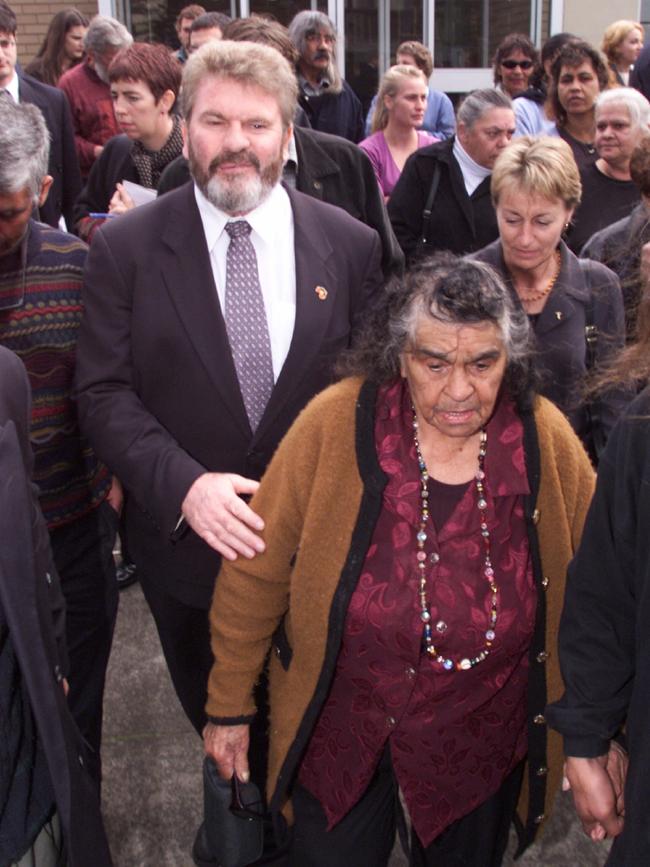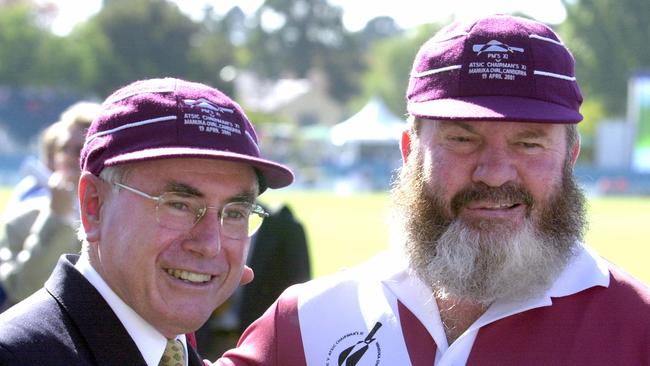Geoff Clark: How his crimes and his ego poisoned Indigenous affairs all the way up to the Voice
How Geoff Clark’s crimes and his ego poisoned Indigenous affairs all the way up to the Voice.
Just the sight of Geoff Clark made some Australians want to vote No to the Indigenous voice.
And that suited him.
The former chairman of the Aboriginal and Torres Strait Islander Commission arrived at the landmark Uluru convention in 2017 to make the case against an Indigenous advisory body in the Constitution. When he complained there had been “no consultation” on the long walk towards a referendum, Aboriginal people familiar with his methods knew he meant there had been insufficient deference to him.
For proponents of the voice, Clark’s interventions during the campaign were as unwelcome as they were unsurprising.
“It was always about Geoff Clark,” said Geoff Scott, once an acting chief executive of ATSIC. “His story is a very sad one for the whole Aboriginal community. It cast that shadow over everything”.
Clark, now 72, is in prison awaiting sentencing for stealing almost $1m from the Aboriginal community in rural Victoria that he had ruled for decades.
His criminal downfall has prompted an outpouring of regret, anger and even grief from Aboriginal leaders and policy makers, who see Clark as the symbol of 25 years of dysfunction and corruption in Indigenous affairs.
An outline of the prosecution case, released by the Victorian County Court, shows the police investigation was lengthy and complex. It took about 11 years for police to unravel Clark’s offending over 16 years.

One whistleblower – an Aboriginal elder – died waiting for the outcome. There were four trials, each subject to suppression orders until this month. Clark’s critics describe him as intelligent, but the court documents suggest he got sloppy at some point.
For example, Clark committed perjury when he swore an affidavit in which he stated he did not hold any real estate. The prosecution showed Clark held three properties and legal title for each of these was registered in his name.
“He kept a folder marked ‘Geoff’s houses and land’ at his house in which he stored documents pertaining to his purchase and improvement of these properties over the years,” the prosecution stated.
Clark is not only a thief, he is a great wrecker in the modern era of Indigenous affairs, according to Fred Chaney.
It was around 2000 when Chaney – who had been Malcolm Fraser’s Indigenous affairs minister – watched in awe as Clark gave a compelling and succinct explanation of ATSIC’s work towards a treaty. “Clark was a person of terrific ability who, as it turned out, had so many ugly aspects to his character,” Chaney said. “The trouble with terrific ability is that, when badly used, it is disastrous. Clark brought the whole thing undone because it was his personal reputation that enabled ATSIC to be attacked so effectively … he provided ammunition for the assimilationists to pull down Aboriginal organisational structures notwithstanding those structures were operating more effectively than the ones they replaced.
“It’s been all downhill in Indigenous affairs since.”
By 2001, Clark was embroiled in a power struggle with his deputy, Ray Robinson, and fending off allegations from four women who said he raped them. A special audit did not uncover fraud at ATSIC. Regardless, perceptions were growing that the organisation was problematic.
In 2002 the Brisbane Courier-Mail aired allegations that Robinson, the deputy, had received money to which he was not entitled from a taxpayer-funded organisation. In 2011, after a retrial, Robinson was put on a good behaviour bond after being found guilty of misappropriating $45,000, part of the proceeds from the sale of 10 cars owned by community-based Aboriginal corporations formerly under his control. His appeal was dismissed in 2012.
Noongar lawyer Hannah McGlade recalls that in the early 2000s, ATSIC at the federal level was a men’s club characterised by sleaze and disrespect to Aboriginal women. She was an ATSIC executive, hired for her qualifications in international human rights law to work on treaty, yet she said Clark spoke down to her.
When McGlade was invited to a human rights convention in Ireland, she asked ATSIC for permission to attend but could not get an answer. McGlade quit before she found out why. “It became untenable after the sexual assault allegations against Clark,” she said.
McGlade turned her anger into a PhD about sexual assault and violence against Aboriginal women and children, and became an even stronger advocate for them. She later learned from a story in The Australian that Clark had taken her work trip to Ireland, and stayed only two nights at the week-long convention.
Freedom of Information documents showed he toured Ireland with his wife and friends, with stopovers in London and Singapore. In all, Clark’s week abroad in 2022 cost the taxpayer $31,000 or $50,200 in today’s money. McGlade says Aboriginal women did excellent work at ATSIC, especially in the regions, but they were not properly acknowledged for this under Clark’s leadership.
Clark’s tenure was a contrast to ATSIC’s early years when Aboriginal women were in charge. Pat Turner was the chief executive from 1994 to 1998 and Lowitja O’Donoghue was the government-appointed chair from 1990 to 1996. Turner went on to rewrite the Closing the Gap agreement with Scott Morrison. When O’Donoghue died in February aged 91, Noel Pearson described her as the greatest Indigenous leader of the modern era.
He said her six years as chairwoman were “ATSIC’s best years”.
“They were years of great coherence in Indigenous affairs, before the national commission’s subsequent poor leadership played into the hands of the Howard government’s antipathy to all things Indigenous,” Pearson said in his tribute to O’Donoghue.
Amanda Vanstone was the minister who suspended Clark in 2003 after he was convicted for obstructing police during a pub brawl. “He was a sharp one, he was always being nice to me saying things like ‘you’re all right, not like all your Coalition mates’. Full on blatant sucking up really,” she said.
Vanstone recalls a detective phoned her about Clark more than 10 years ago. Those were the early days of Operation Omega which slowly established how Clark had stolen from the Framlingham Aboriginal Trust and three related entities. Across multiple trials, Clark was found guilty of 25 charges. His son, Jeremy Clark, 51, was found guilty of seven charges including theft and false accounting.

Vanstone says she is particularly troubled by corruption in Indigenous organisations because of who it deprives. “The key thing is that when you have people up the top creaming the money out of Indigenous affairs, people underneath aren’t getting it,” she said.
“In that sense, corruption in Indigenous affairs is more detrimental than some other areas because it is at the expense of people for whom life really is very difficult. There are plenty of really good people genuinely trying to do the right thing and then you have others helping themselves and their family, hurting people who need the most help.”
Though Clark was reinstated the year after Vanstone suspended him over the pub brawl conviction, John Howard’s gutting of ATSIC was under way in 2004. Labor’s then leader, Mark Latham, made abolishing ATSIC an election promise. On March 16, 2005, parliament disbanded the federal body that had been elected by Aboriginal and Torres Strait Islander people to be responsible for half the commonwealth budget for Indigenous-specific programs.
Clark was never convicted of rape. However, a jury at a 2007 civil trial found he led two pack rapes at Warrnambool in March and April 1971.
Aboriginal entrepreneur Sean Gordon, a conservative who supported the Indigenous voice, said Clark should have resigned as chairman for the good of ATSIC. However, Gordon says that the Howard government’s decision to shut ATSIC down rather than deal in the usual way with an organisation’s leadership problems has had lasting ramifications.
“I have no doubt it was on people’s minds during the voice debate,” Gordon said.
“That government response to ATSIC is inconsistent with their response to other elected representative bodies such as local government authorities.
“When they are dysfunctional they aren’t wound up but are put into administration and councillors replaced. The body itself remains intact … unfortunately we got special treatment.”
Vanstone herself was not entirely sure that abolishing all of ATSIC was the answer.
Mick Gooda, Australia’s former social justice commissioner, told The Weekend Australian that Aboriginal people knew Vanstone had fought and lost in cabinet to keep the regional councils.
Vanstone confirmed she saw the value of ATSIC in the bush.
“I do have a slight lingering doubt about getting rid of all the regional offices,” she said. “I did think at the time it might be worth keeping some of the regional offices for the purposes of getting information from those offices and feeding it into Canberra.”
In her travels as a minister, Vanstone said she saw first hand the disconnect between the government and its Aboriginal constituents in regional and remote areas. She said she also saw people living in appalling conditions while their land councils or Aboriginal corporations managed many millions of dollars.
“I still think and worry about what we need to do,” she said. “Once you’ve had Indigenous affairs you never let go of the things you have seen.”



